Testing a 1964 Austin Gipsy
Posted by Chris Graham on 4th May 2023
Zack Stiling sings the praises of the Austin Gipsy that, despite many views to the contrary, is a pleasant and eminently capable off-roader.
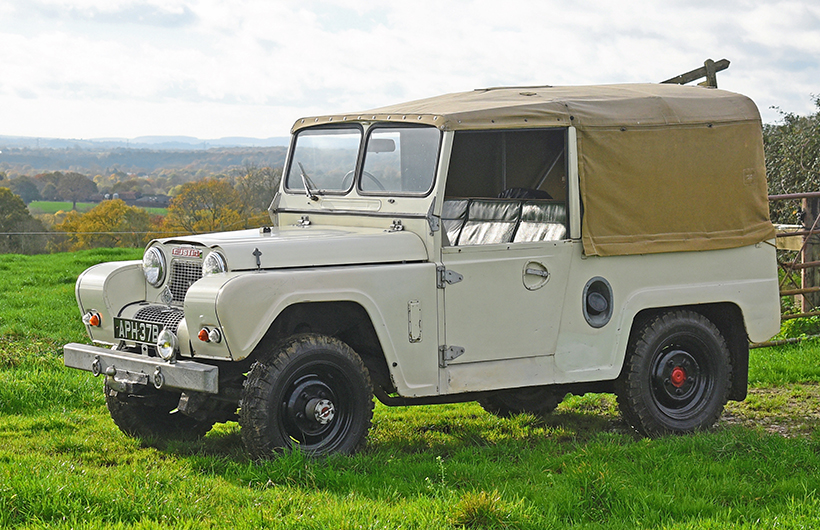
This 1964 Austin Gipsy is ideal for getting across rough country in the South Downs and Surrey Hills.
Last time we examined an early Land-Rover which, like the Willys Jeep before it, set the template for what a small off-roader should be – durable, straightforward and widely adaptable. It wasn’t until the 1970s that many other marques attempted the same formula, but there had been one serious and very creditable home-grown effort in the 1950s and ’60s; the Austin Gipsy.
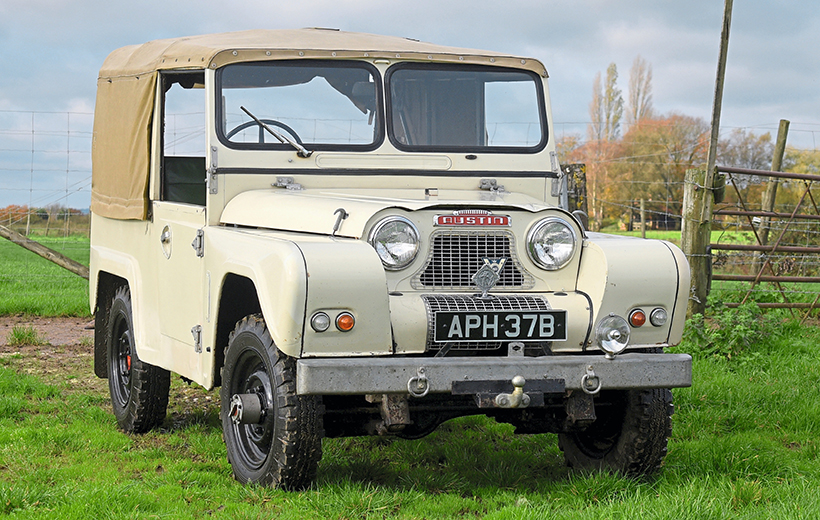
Old English White is this Gipsy’s original paint colour.
It’s obvious enough that by making the Gipsy, Austin hoped to capitalise on Land-Rover’s success and threaten its monopoly. Of all the British marques, it made sense that the challenger should be Austin because it had extensive, recent experience of making a light off-roader, the Austin ¼-ton 4×4 truck, or Champ.
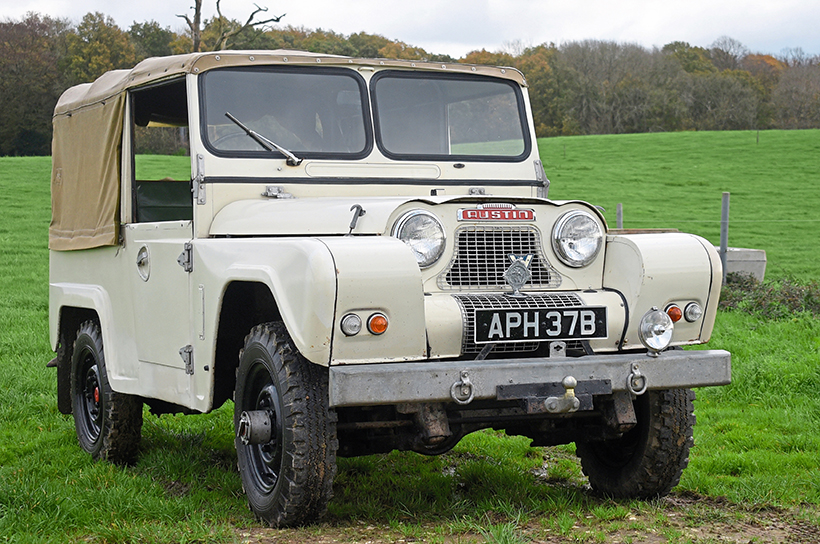
Despite being worked hard for most of its 59 years, this 1964 example still looks wonderful.
The Champ was conceived as a British alternative to the Jeep but, unlike the Land-Rover, it was designed to meet a British Army specification. Though excellent in action, its complex design was its downfall. It was expensive to build and sell, and it made on-the-go maintenance and repairs unhelpfully difficult.

Covered in wet sand, the Gipsy has rather a playful look.
The Champ was made in very limited numbers for the civilian market and, when the Gipsy superseded it in 1958, Austin had learnt its lesson. The Gipsy embraced every principle of Land-Rover design and, in almost every regard, it was a worthy competitor. One respect in which it differed significantly was in its suspension, which was independently sprung with Flexitor rubber in torsion (except for the rear springing of the lwb version), whereas the Land-Rover used traditional cart springs. This was a particularly unconventional method of suspension which, at the time, had few other automotive applications besides the Bond Minicar. Doubtless Austin thought itself very modern and forward-thinking, but there are instances in off-roading where independently sprung wheels may be lifted simultaneously and cause bottoming out. Consequently, ordinary leaf springing became an option in 1962.
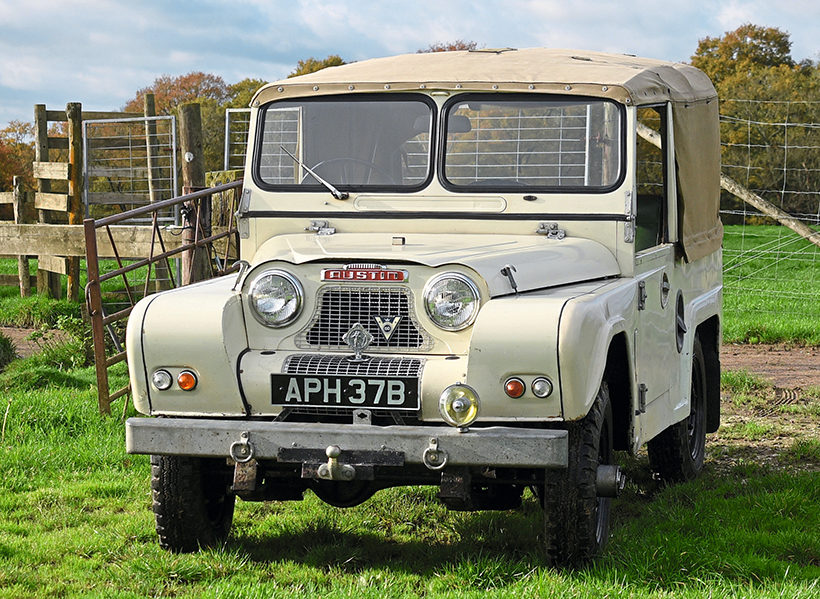
Originally, this Gipsy was used by Paddy’s Garage in New Malden.
As with the Land-Rover, Austin lifted the Gipsy’s engine directly from a passenger car, in this case the dependable 62hp, 2,199cc four formerly used in the Austin 16 and A70. A diesel Land-Rover became available in 1957, so a 55hp, 2,178cc diesel alternative for the Gipsy was available from the start. Naturally, the gearbox was a four-speed with a low-gear transfer box to assist with rough country or disengage the front drive. Ten-inch two-leading-shoe brakes worked at each wheel.
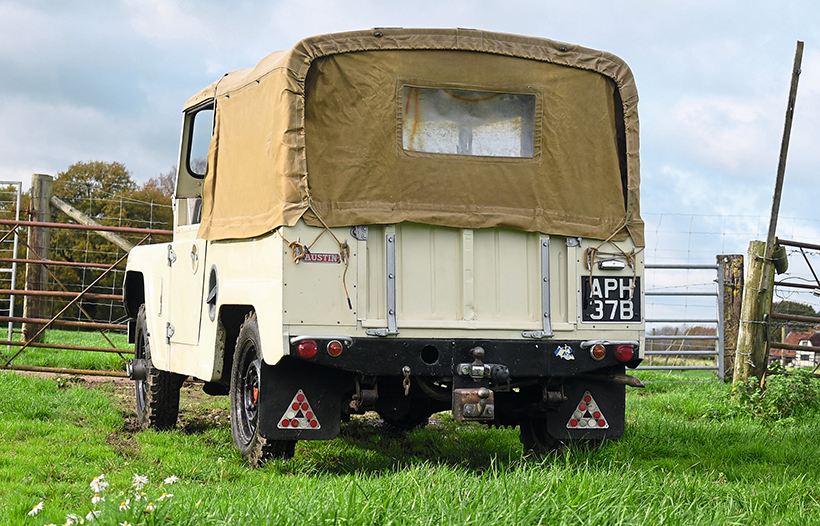
The canvas soft-top is versatile, although visibility is limited.
Gipsys were demonstrated before an approving press at the Fighting Vehicle Research and Development Facility at Bagshot Heath, where it was reported that they would cruise at 60mph on the road, onward to a top speed exceeding 70mph. Off-road, they were said to press-on indestructibly at 50mph and tackle 1-in-3 mud and sand hills at 20mph in second gear with two-wheel-drive. These figures are improbable; The Autocar’s 1959 road test returned a best top speed of 65mph. Fuel consumption may have been a shortfall. It would return an acceptable 16-23mpg under normal use on varied ground, but The Autocar made one drive across soggy grass on flat but bumpy land using low-ratio second and third and, with wheelspin to overcome, returned just 4mpg.

Rolling up the back makes the world of difference.
Ostensibly, the Gipsy imitated the Land-Rover in its chassis and body, with short- and long-wheelbase versions offered, hardtops and soft-tops, and the same range of catalogued bodies, including pick-up, personnel carrier (decidedly militaristic language for what Land-Rover called a station wagon) and fire tender. The short-wheelbase had a 16cwt payload, while the long-wheelbase was a latecomer, arriving with the mildly face-lifted Series II in 1960. The roof, frame and doors were all removable, and the windscreen folded flat.
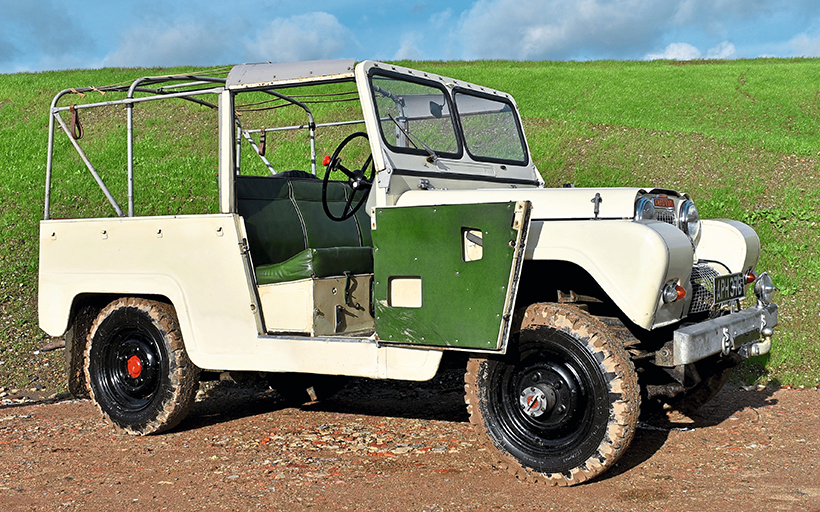
With the whole roof removed, the Gipsy is delightful in nice weather.
There was just one superficially unobservable difference, though, which sealed the Gipsy’s fate. The Land-Rover’s expensive but non-corrodible aluminium alloy body panels ensured its survival and longevity. The Gipsy’s body is welded steel pressings, which may not have troubled every buyer when new, but its survival rate rather speaks for itself.
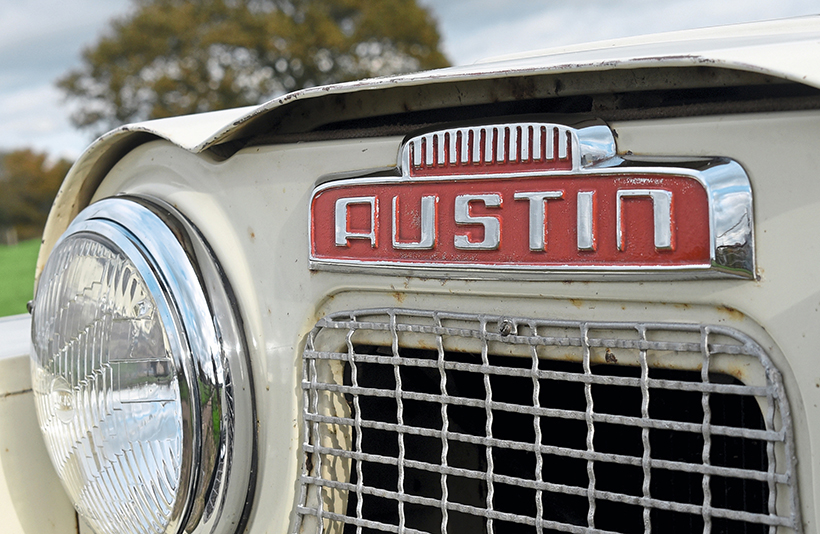
No flying ‘A’ or stylised script – the Gipsy’s badge is clear and straightforward.
Despite enthusiastic promotion and publicity, the ‘Go Anywhere’ Gipsy couldn’t steal Land-Rover’s crown. In 1960, Birmingham dealer Evans & Kitchen displayed a Gipsy on the showroom roof, supposedly having been driven up a 1-in-1 slope, but police ordered its removal fearing it would distract motorists. A second 1-in-1 slope was made at Longbridge, which a Gipsy was demonstrated driving up and down. In June 1962, some students took one to the top of Ben Nevis.
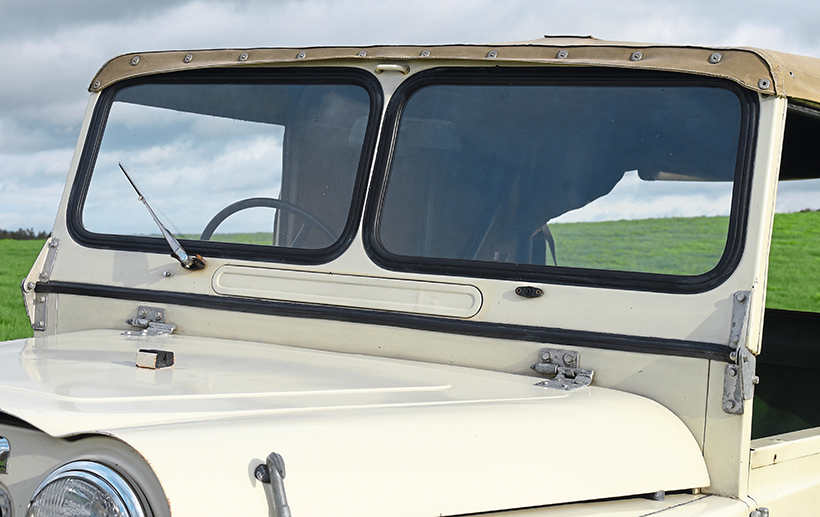
The windscreen can be lowered completely.
Had the Gipsy been significantly cheaper than the Land-Rover, it might have been built in larger volume, but costing £650 in 1959 for the standard-bodied petrol version, and £800 for the diesel, it lacked the advantages which might have tempted more buyers towards it. The hardtop was £50 extra, and other early options included power take-off with pulley drive at £47 10s, power take-off with shaft drive at £38, front-mounted winch at £46, heater at £10 and passenger-side windscreen wiper at £3 7s 6d.
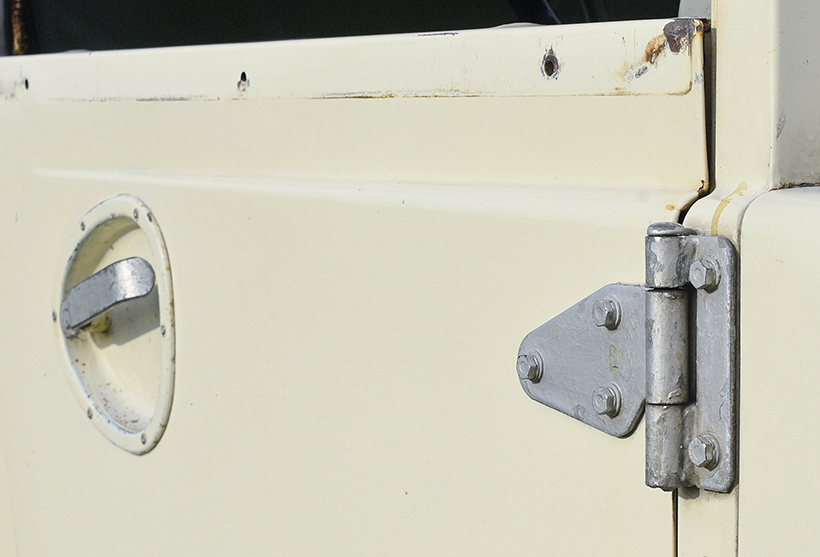
Steel panels unfortunately proved the Gipsy’s downfall.
Steve Fickling was one of many people who, on first seeing a Gipsy, thought he was admiring a Land-Rover. He was at a customer’s house, who corrected him as to the vehicle’s identity. On his second visit, he took a closer look and further expressed his admiration, even if he was still referring to it as a Land-Rover… Six months later, in February 2013, he received a phone call informing him that the Gipsy would be for sale, and offering him first refusal.
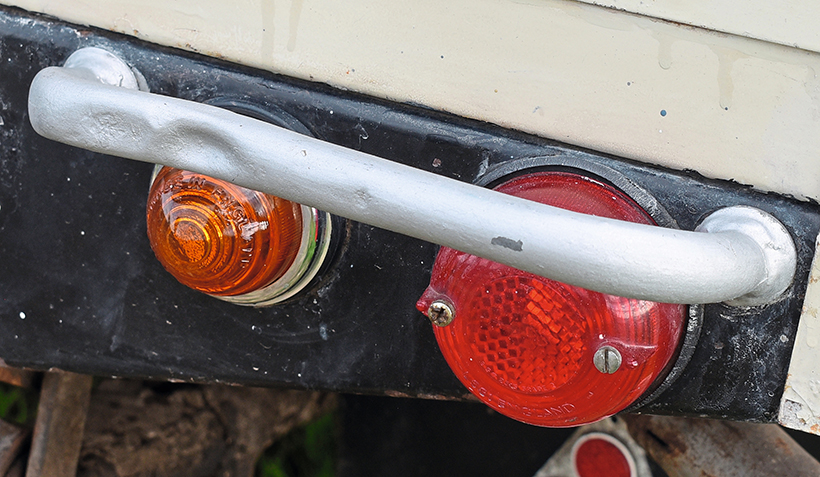
Sturdy bars provide simple but effective protection for the rear lights.
Steve gave in to temptation, and ended up with not just a very nice 1964 swb soft-top Gipsy, but one which is also extremely original and historic. It was bought new in January 1964 by Alan Paddy, and had remained in the Paddy family ever since. Purchased from the Wimbledon Motor Works, an Austin and Vanden Plas distributor at 29 High Street, Wimbledon Common, it went straight into service with Paddy’s Garage Ltd, the family business located at 59 Kingston Road, New Malden, Surrey. Paddy’s opened in 1938, with Alan in charge of the workshop while brother Cyril took care of car sales and admin. By 1964, it was an Austin dealership, and the Gipsy was used for recovery, although it never had a crane fitted.
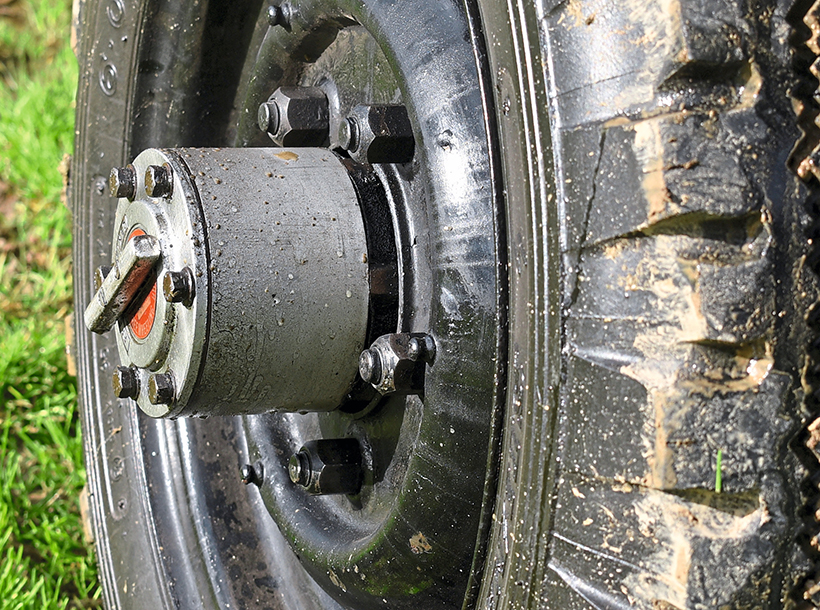
Steve’s Gipsy is fitted with freewheeling hubs.
Finished in Old English White, Alan bought it with the optional extras of a heater (£10) and a trailer lamp socket (£2 10s), bringing the price to £692 10s, but he qualified for a 22.5% discount which knocked it down to £536 13s 9d. In 1970, Paddy’s was sold and Alan retired to Swanage, using the Gipsy for towing his various boats, hence the three tow bars. He must have become fond of it, as he became an active member of the Austin Gipsy Register.
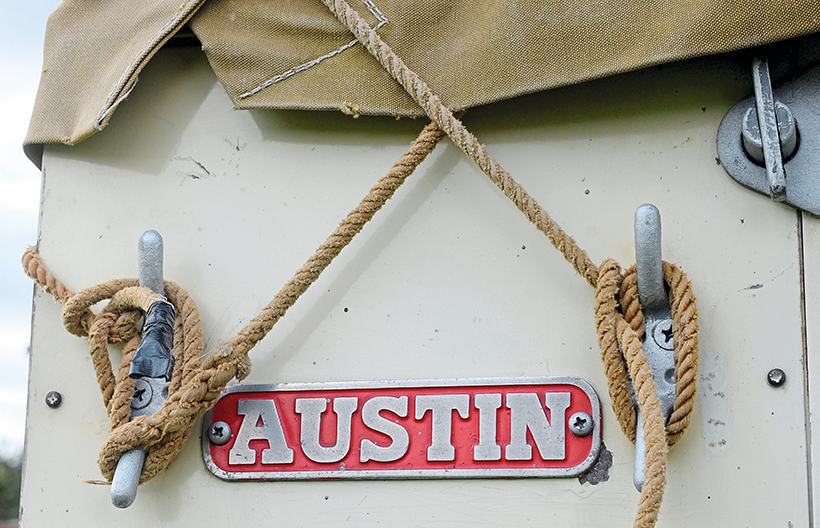
The canvas is securely fastened in place with ropes.
His son Philip started driving it as soon as he passed his driving test in 1965, and he inherited it on his father’s death in 1995. His trade was in the restoration of old timber boats, so the Gipsy was used for the transport and recovery of his Thames river launch. Philip’s nephew Nick took it over in 2009 but, being occupied with his classic Mini race-preparation business, he didn’t get time to use it.
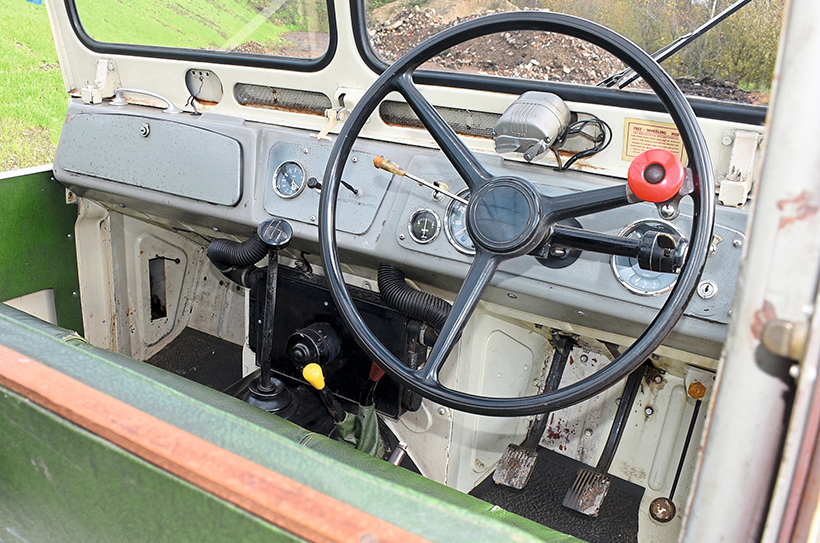
The Autocar described the interior as ‘lorry-like.’
That’s why, when Steve bought it, it needed a spot of recommissioning. He says: “It hadn’t been driven for nine years. The clutch was seized and it needed new wheel cylinders and a couple of brake lines but, after charging the battery, it started almost immediately.” Now, with Steve’s interest in country pursuits, it gets used every summer for logging, transporting him through woodlands and over fields, and generally doing the things which few other cars can do.

The doors are simply trimmed, as one would expect.
We ventured out but, unfortunately, the November rainfall limited how much off-roading we could do as the ground is waterlogged, and the local clay soil traps even modern off-roaders when it turns into a bog. Nevertheless, there were plenty of opportunities for weighing it up against its rival Land-Rover. Although, on paper, the Gipsy should be larger – it has a 90- or 111-inch wheelbase to the Land-Rover’s 88 or 109 – it looks and feels like the smaller vehicle. Ground clearance of 8½ inches is roughly equal to a typical Land-Rover but, to the Gipsy’s credit, it doesn’t require such a high step to enter. However, once inside, a little more legroom might be appreciated.
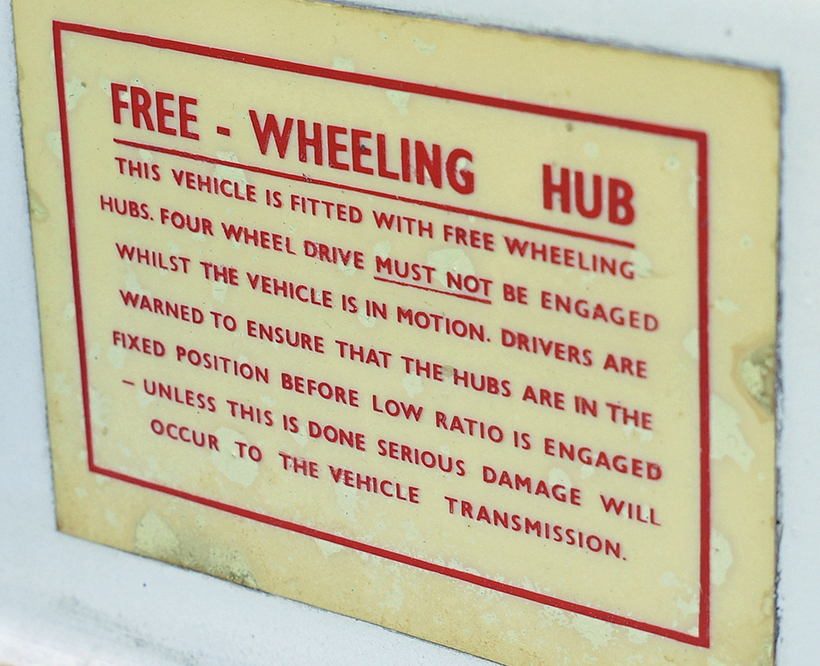
The freewheel assists with fuel economy when on the road.
The Gipsy feels a much nimbler vehicle to manoeuvre, and the light, low-geared steering undoubtedly helps. Possibly, it’s better suited than the Land-Rover to more confined paths and tracks. The downside, however, is that it was only ever a six- or eight-seater, even with the spare wheel on the bonnet to make extra room in the rear. Although the front bench seat looks like it will take three, as the Land-Rover’s would at a pinch, the restricted legroom and proximity to the tall gear-lever really renders it unsuitable.
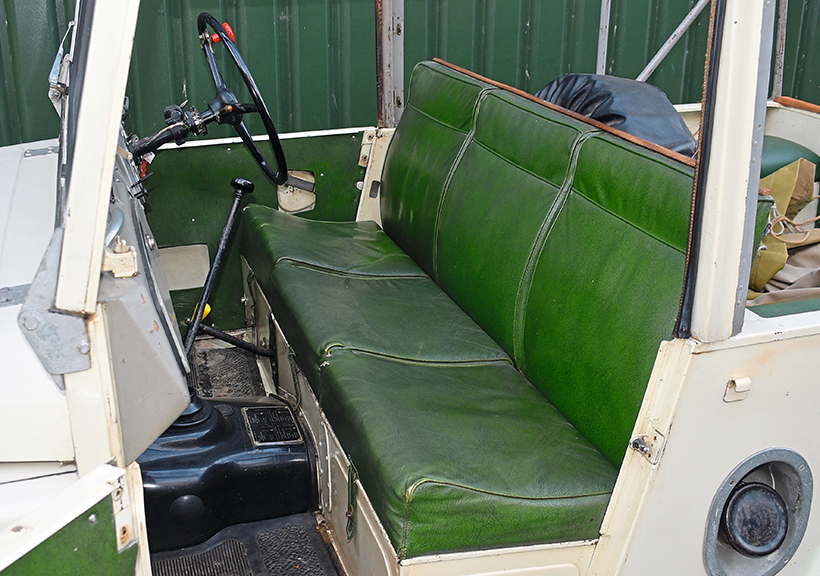
The seats, trimmed in PVC-coated leathercloth, are comfortable enough.
Since we weren’t venturing too far off-road, we kept it in rear-wheel-drive and headed for a steep hill, which it climbed steadily but surely and, on returning to the bottom, it remained true as it ploughed through the quagmire of wet mud, quite unfazed.
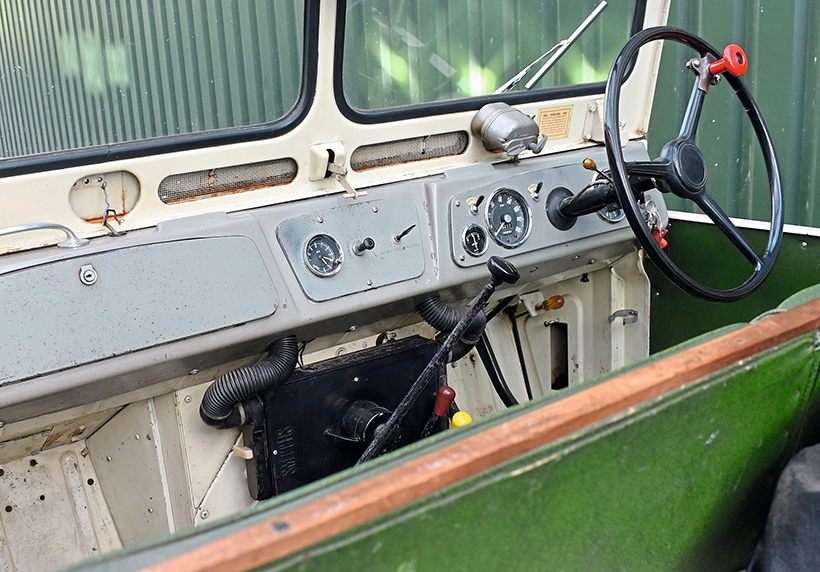
Despite its Spartan nature, this Gipsy benefits from a locking glovebox, Smiths clock and heater.
Steve says of his leaf-sprung example, “It’s really, really easy to drive. Having four forward gears means you rarely use first, unless you’re carrying a lot of weight. It’s comfortable to drive. It would probably be better if I was a few inches shorter, because it’s a bit cramped, but you get used to it. Anything over 50mph isn’t much fun – 45 is the optimal cruising speed – but it wasn’t designed for speed.
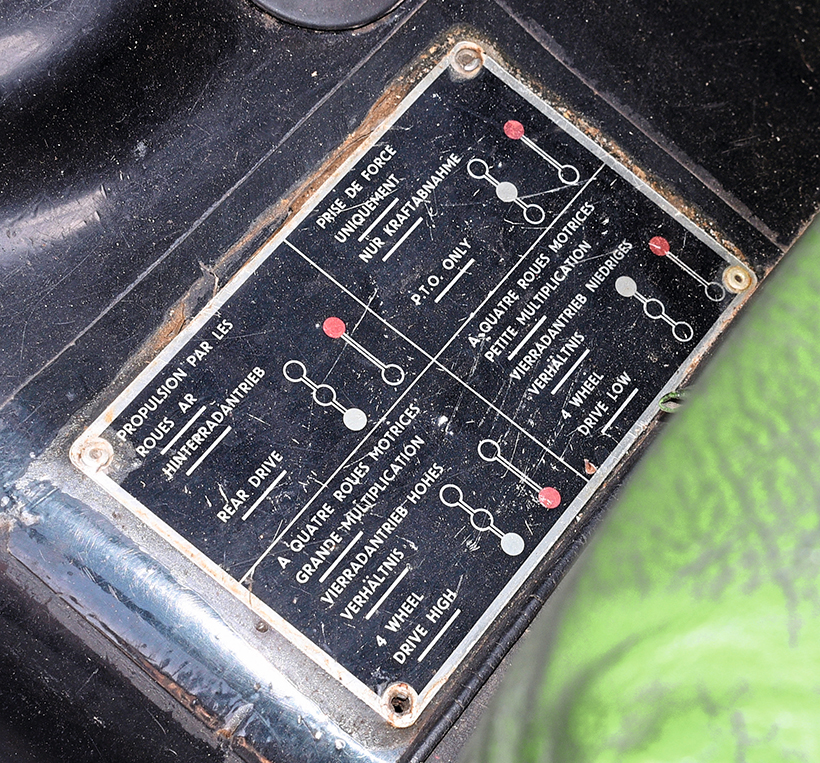
The lowest gear ratio is 41.927-to-one.
“Off road, it really comes into its own. I feel quite confident driving it at all angles, going uphill and downhill. Obviously it’s got a very big steering wheel, which can be something you have to get used to, but it handles really nicely. I’m amazed by how much you can throw it about. I drive it like a modern car in many ways. You sometimes have to give the brakes a pump, but it stops very well.
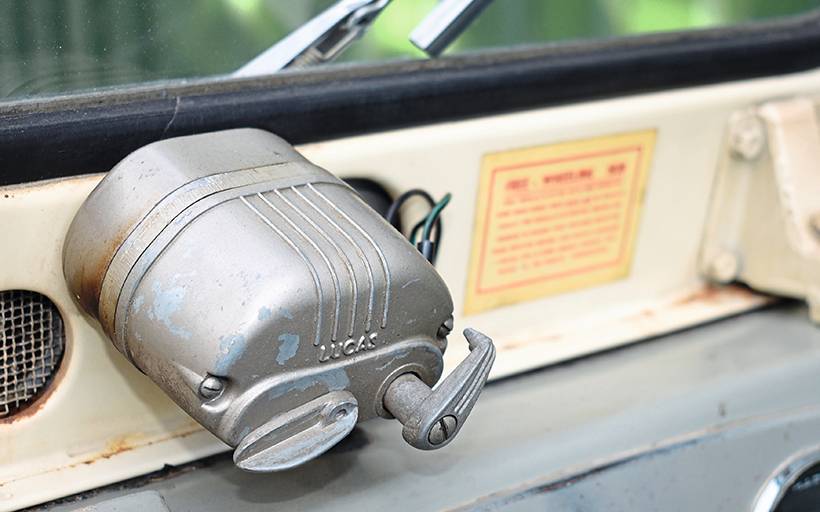
A passenger-side windscreen wiper was only an option.
“The best thing is that it’s such an easy vehicle to maintain, for someone who’s not mechanically minded. There are not many things to attend to and you can service it all on your own. A lot of the parts are shared with the Austin A70, so most are fairly available.”

The interior displays a lovely patina acquired over six decades.
Steve’s caution about off-roading at this time of year is understandable although, having seen how well the Gipsy climbed a muddy hill, I’m not inclined to doubt its ability. Still, if we content ourselves with mainly driving on Tarmac, my impressions are nothing less than favourable. By 1964, the engine had been tweaked to increase output to 72hp, so it motors along quite briskly. The light steering and manoeuvrability has already been remarked upon, but it stops well, too. Unfortunately, rear visibility with the top raised isn’t good, and the small, 60-year-old Perspex window is probably not as clear as it was.
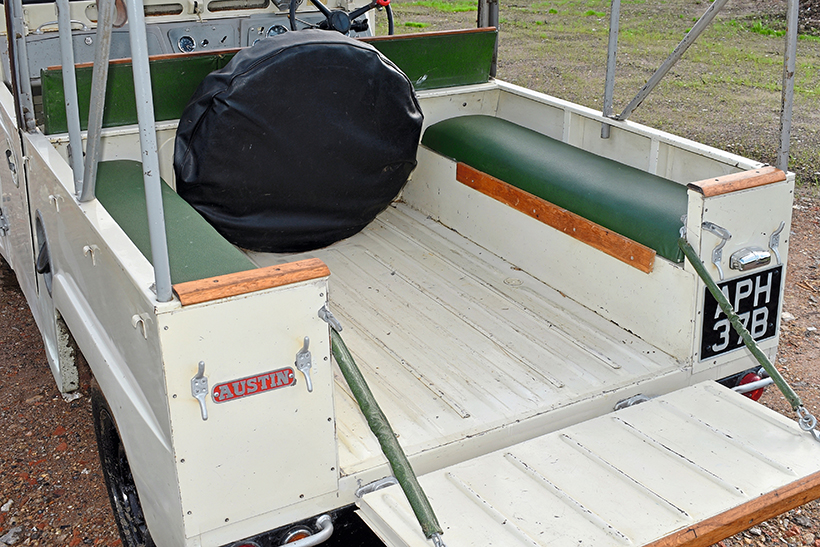
The pick-up section is utilitarian, but ideally suited to transporting goods or people.
With consideration, the Gipsy’s steel panels, confined interior, clever but fallible Flexitor suspension and other small shortcomings like the exposed propshaft which, The Autocar complained, had a tendency to get covered in long grass, may mean that it’s not as well-suited to serious, everyday off-road use as the Land-Rover. However, it’s probably even better if viewed as a lighter-duty leisure vehicle, eg for getting down to the riverside with a boat trailer, or for mixed on- and off-road use in the drier months, with roof and doors removed and the summer breeze on your skin.

The simple, owner-friendly 2.2-litre engine was first seen in the 1940s Austin 16.
Of course, the concept of a leisure vehicle was non-existent in Britain in 1958 and, by the time the idea was gaining ground, BMC already had the Mini Moke. When Land-Rover was incorporated into British Leyland in 1968, it made no sense to have the Gipsy in direct competition with it. In its 10-year life, just 21,208 Gipsys had been made compared with over 400,000 Land-Rovers in the same period, so it was quietly dropped. Although only a fraction of that 21,000 survives today, the Gipsy has shown itself to be a far better car than its rarity would suggest and, while Land-Rovers may outnumber it, the Gipsy is undoubtedly more of a talking point.

Steve Fickling never expected to become a Gipsy owner but, 10 years after purchase, he still loves the vehicle.
This feature comes from a recent issue of Old Glory, and you can get a money-saving subscription to the magazine simply by clicking HERE





